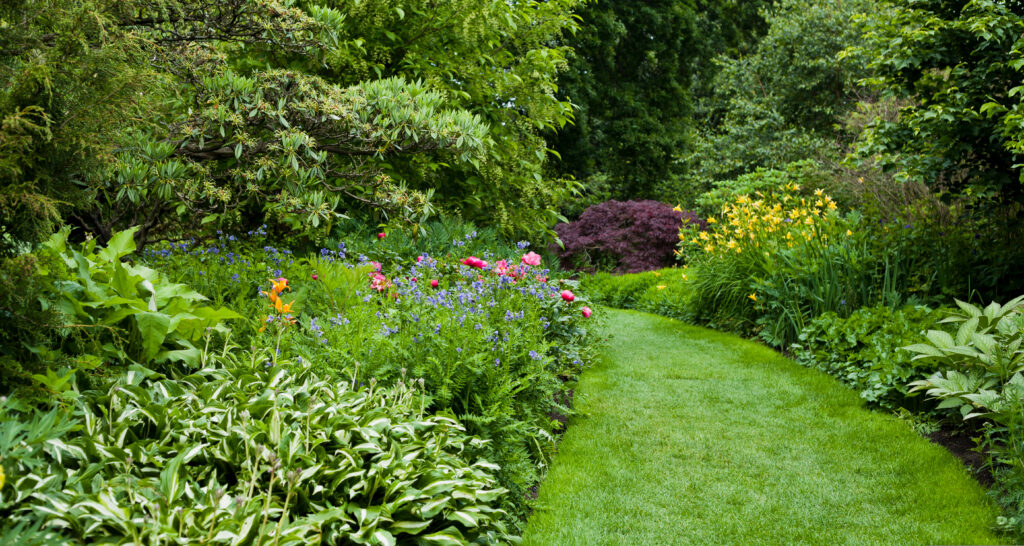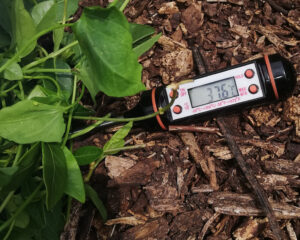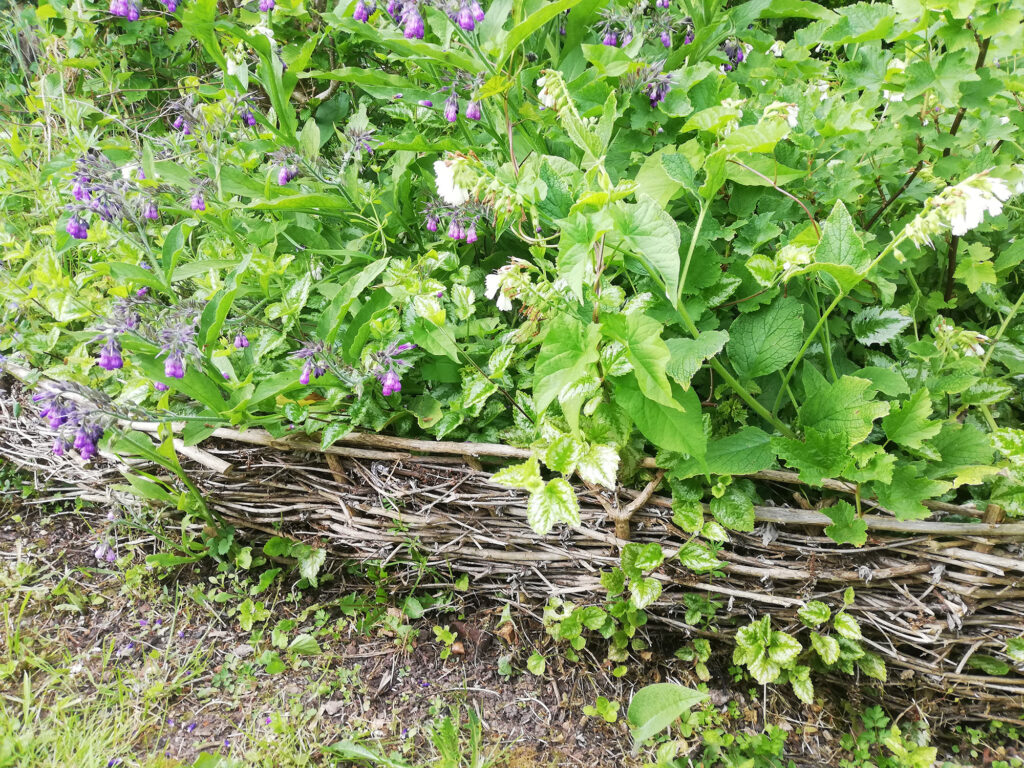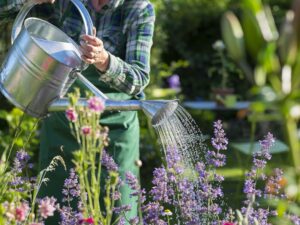Keep plants cool without wasting water
As the weather heats up, gardeners will be reaching for watering cans or hoses. But as horticultural scientist Janet Manning explains, you can help your plants by encouraging their natural ability to cope in hot weather.
After the hottest June on record in the UK, gardeners will have appreciated any shade in their garden to shelter from the sun. It may seem obvious, but we can move to get out of the sun and pour a cold drink. You can’t do either of those things if you’re a plant and can’t move! It’s fascinating how plants have evolved to learn to live without legs. They are literally rooted to the spot, so have developed natural ways to cope in dry weather. This means as gardeners, we can make the most of nature’s ability to cope with heat, and reduce the need for more watering when the temperature rises.
Plants can help each other
Have you noticed that grass growing close to a tree or hedge is often the last to turn brown? This is because the tree or hedge is taking the heat and shading the soil beneath its canopy. Big plants help small plants when there’s moisture in the soil. The shade from the big plants reduces the evaporation of water from the soil surface, helping the grass stay greener for longer.
Big plants also have deeper and more extensive roots, so can reach water held in much larger and deeper volumes of soil. Furthermore, when the moisture evaporates from the tree’s leaves it cools the surrounding air, further benefiting the nearby grass.

Layered planting creates shade so the soil is never exposed to direct sun
Layered planting creates shade
Gardeners can make use of the shade created by large canopies of foliage, by designing planting in layers, also known as forest planting. This is done with lots of different heights of plants, from trees through to ground cover. Having varying heights of plants creates shade so the soil is never exposed to direct sun. This way the soil surface stays cooler, less water evaporates, and the moisture lasts longer. With different plants having varying root depths, they can draw moisture from different depths of soil, so plants can help each other benefit from all the moisture that’s available.
Create shade for root zones
On the longest day in the UK there is around 16 hours of sunlight. Plants will keep using water and the sunlight for photosynthesis during the long days. But gardeners can reduce the stress for plants and save on watering, by using shade to turn down the sun’s intensity.

Mulch shades the soil and keeps it moist (pictured is sheep wool on top of wood chip)
Firstly start with shading the soil with an organic mulch, such as wood chip, straw, grass clippings or sheep wool. This will insulate the roots from the radiant heat, keeping moisture in the soil. At home in my own south facing garden, I measured the temperature of dark coloured wood chip mulch using a kitchen thermometer (not a highly scientifically instrument, but good enough). By adding around 30 mm of material, the temperature dropped by 23oC from 45oC on the surface to 22oC underneath! The wood chips drain freely when I do water, so very little water stays in the mulch to evaporate. Sheep wool also makes an excellent mulch. A friend of mine uses this on her allotment and I found temperatures under the wool mulch were lowered by 14oC in a poly tunnel and 16 oC on an outside bed.

Leave pulled weeds like this bindweed on top of mulch for further shade
This made me curious. After weeding would I be exposing even more soil to the heat of the sun when I take the weeds away to the compost bin? What if I leave them to wilt on the surface instead? It would mean less work for me carrying everything away and less watering if it reduced the temperature further. It worked well, a small pile of loose bindweed left on the mulch surface for only a few minutes took the temperature of the surface of the mulch down by around 8oC.
Secondly, a border edging can also double up as root zone shading. In the photo below you can see I created a simple woven border edge using the woody prunings from a Buddleja. I’m always looking for multiple benefits and this does several jobs:
- it makes use of woody prunings that wouldn’t fit into a bulging compost bin
- it puts decaying wood into the soil which will encourage the mycorrhizal fungi in the soil
- it shades the root zone in the border from the sun
- it also stops my husband strimming my plants when he does the edges of the lawn!

A border edging has multiple benefits including shading soil from the sun
Put containers in the shade
In the middle of the growing season, it will be too late to re-design planting for now, but there are still ways to incorporate shade. With containers you can simply move them into partial shade, or put up a parasol during the heat of the day. They will also benefit from being pushed close together so that the pots are shaded by each other’s foliage, and they share the humidity from the leaves. Metal pots may be trendy now, but they will heat up and cook the roots if they are left in full sun.
Train your plants to adapt in the heat

Don’t saturate soil to encourage your plants to use less water
It may sound counter-intuitive, but don’t be tempted to saturate the compost in containers. When plant roots are kept very wet all the time they won’t cope as well when them become dry, and they will more likely wilt. This is because plants that have a partially dried root zone produce abscisic acid, which is a chemical messenger that closes some of the stomata (the little pores in the leaves that let the water vapour out). By letting less water out, the remaining soil moisture will last that little bit longer, until either it rains or the gardener comes along with a watering can. You can encourage your plants’ abscisic acid by not fully saturating the compost at each watering, or only watering on one side of the pot.
Help your plants help themselves
By shading your plants and not overwatering, your plants will better cope in hot weather and need less watering. You can start today with some small changes, and also think ahead to when you plant next year:
- Cool the soil and root zone by using organic, free draining mulch. You can also leave weeds to wilt on the surface
- Turn down the intensity of the sun in the middle of the day by moving plants in containers into shady places, put up a sun parasol, or push them together
- Don’t overwater! Plants adapt to lower moisture levels and will be less likely to wilt
- Remember the stress of hot weather on both the garden and gardener and think about designing in layered or forest style planting, using the foliage canopy to create shade
There’s plenty more top advice from Janet on growing better plants while saving water. Have a go at making your own mulch or read more on how much water your plants really need.
Back